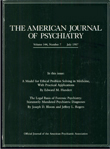Changes in Regional Brain Glucose Metabolism Measured With Positron Emission Tomography After Paroxetine Treatment of Major Depression
Abstract
OBJECTIVE: Depression is commonly associated with frontal hypometabolic activity accompanied by hypermetabolism in certain limbic regions. It is unclear whether successful antidepressant treatments reverse these abnormalities or create new resting levels of metabolism. The aim of the present study was to assess the effects of successful paroxetine treatment on regional glucose metabolism in patients with major depression. METHOD: Positron emission tomography with [18F]fluorodeoxyglucose was performed on 13 male patients before and after 6 weeks of paroxetine therapy. Resting state scans were also acquired under similar conditions in 24 healthy male subjects for comparison. RESULTS: After successful paroxetine therapy, increased glucose metabolism occurred in dorsolateral, ventrolateral, and medial aspects of the prefrontal cortex (left greater than right), parietal cortex, and dorsal anterior cingulate. Areas of decreased metabolism were noted in both anterior and posterior insular regions (left) as well as right hippocampal and parahippocampal regions. In comparison to metabolism levels in a group of healthy volunteers, the increase in prefrontal metabolic activity represented a normalization of previously reduced metabolic activity, whereas the reduction in pregenual anterior cingulate activity represented a decrease from previously elevated metabolic levels. CONCLUSIONS: These results provide further support for a dysfunction in cortical-limbic circuitry in depression, which is at least partly reversed after successful paroxetine treatment.



